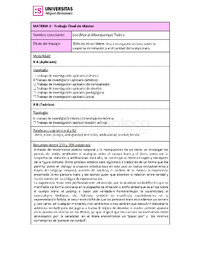Por favor, use este identificador para citar o enlazar este ítem:
https://hdl.handle.net/11000/25740Registro completo de metadatos
| Campo DC | Valor | Lengua/Idioma |
|---|---|---|
| dc.contributor.advisor | García Muriana, Carmen | - |
| dc.contributor.author | Alburquerque Tudela, María | - |
| dc.contributor.other | Departamentos de la UMH::Arte | es_ES |
| dc.date.accessioned | 2022-01-26T10:46:52Z | - |
| dc.date.available | 2022-01-26T10:46:52Z | - |
| dc.date.created | 2021-09-01 | - |
| dc.identifier.uri | http://hdl.handle.net/11000/25740 | - |
| dc.description.abstract | A través del movimiento poético corporal y la manipulación de un títere, se investigan los puntos de unión, similitudes o analogías entre el cuerpo trans y el títere, como son la sospecha de imitación y artificialidad. Para ello, se construye un títere a imagen y semejanza de la figura titiritera. Dicho proceso artístico será registrado o traducido de tal forma que me permita poner en diálogo la creación artística (que en este caso se realiza exclusivamente a través del lenguaje corporal, ausente de palabra), el análisis de la misma, la experiencia encarnada como persona trans y las teorías queer que abordan la relación entre verdad y ficción dentro de los códigos de representación. La experiencia trans está profundamente atravesada por la dualidad verdad/ficción que se manifiesta de forma cotidiana en la sospecha de imitación o artificialidad que se arroja sobre el cuerpo trans: el passing o pasar por verdaderx hombre/mujer, la autenticidad, el esencialismo biológico, etc. Además, también se manifiesta repetidamente en la representación ficticia: el recurrente cliché de que las personas trans escondemos un secreto y, por tanto, en cualquier momento, nos tendremos o nos tendrán que descubrir (desvelar la auténtica verdad) para dar jugo a la trama. El tópico de desvelar lo oculto también aparece en la puesta en escena de los títeres, ya que al igual que los cuerpos no normativos están atravesados por la veracidad, en el títere encontramos un “pasar por” y los mismos comentarios de “parecer de verdad” | es_ES |
| dc.description.abstract | The research consists the use of the poetic movement of the body and the manipulation of a puppet to identify the meeting points, similarities or analogies between the trans body and the puppet, such as the suspicion of imitation and artificiality. In order to do so I made a puppet in my own image and likeness. This artistic process will be recorded or translated in such a way as to allow a dialogue to be established between artistic creation (that in this case will take place exclusively through the language of the body without words), an analysis of this, the embodied experience as a trans person and the queer theories addressing the relationship between truth and fiction within representational codes. Trans experience is deeply traversed by the truth/fiction duality manifested in the suspicion of imitation or artificiality routinely hurled at the trans body: passing, the ability to be regarded as a real man/woman, authenticity, biological essentialism, etc. This is also manifested repeatedly in fictional representations: the recurring cliché that trans folk have something to hide and therefore, at any time in order to make the plot more engaging, we’ll either have to reveal ourselves (uncovering the real truth), or it will be done for us,. We also find this cliché of revealing the hidden in puppet shows; in the same way that non-normative bodies are traversed by veracity, this “passing” can also be found in the puppet and the same way that comments are made about “looking real” | es_ES |
| dc.format | application/pdf | es_ES |
| dc.format.extent | 62 | es_ES |
| dc.language.iso | spa | es_ES |
| dc.publisher | Universidad Miguel Hernández de Elche | es_ES |
| dc.rights | info:eu-repo/semantics/openAccess | es_ES |
| dc.rights.uri | http://creativecommons.org/licenses/by-nc-nd/4.0/ | * |
| dc.subject | Títere | es_ES |
| dc.subject | Trans | es_ES |
| dc.subject | Cuerpo | es_ES |
| dc.subject | Ambigüedad | es_ES |
| dc.subject | Imitación | es_ES |
| dc.subject | Puppet | es_ES |
| dc.subject | Trans | es_ES |
| dc.subject | Body | es_ES |
| dc.subject | Ambiguity | es_ES |
| dc.subject | Imitation | es_ES |
| dc.subject.other | CDU::7 - Bellas artes | es_ES |
| dc.title | Esto no es un títere. Una investigación artística sobre la sospecha de imitación y artificialidad del cuerpo trans | es_ES |
| dc.type | info:eu-repo/semantics/masterThesis | es_ES |

Ver/Abrir:
TFM Alburquerque Tudela, María.pdf
18,42 MB
Adobe PDF
Compartir:
 La licencia se describe como: Atribución-NonComercial-NoDerivada 4.0 Internacional.
La licencia se describe como: Atribución-NonComercial-NoDerivada 4.0 Internacional.
.png)